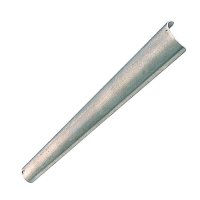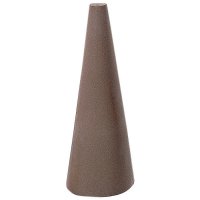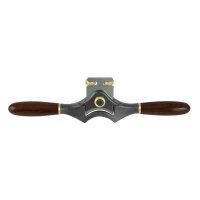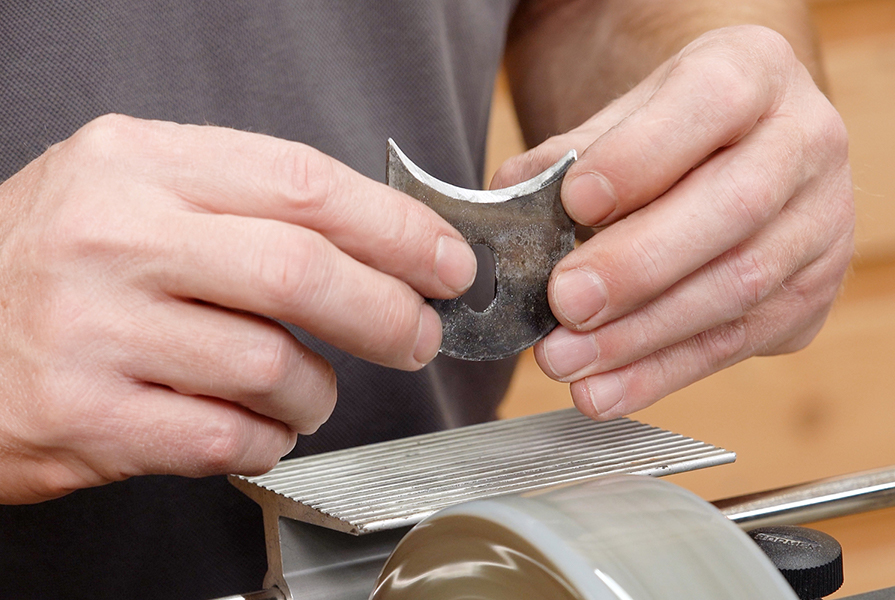
Unlike straight or convex cutting edges, concave cutting edges cannot be sharpened on straight sharpening stones. They need convex sharpening devices. However, this alone is not enough for all tools with such a blade shape. For spokeshaves or beading planes, the cutting edge must fit the plane sole exactly.
Which tools have concave cutting edges?
Most woodworking tools are sharpened on one side. They have a bevelled side and a flat back. These tools are always sharpened on the bevel side. For most carving tools, the bevel is on the outside of the curvature. This means that they have a convex or outwardly curved cutting edge and can be sharpened accordingly on flat sharpening devices.
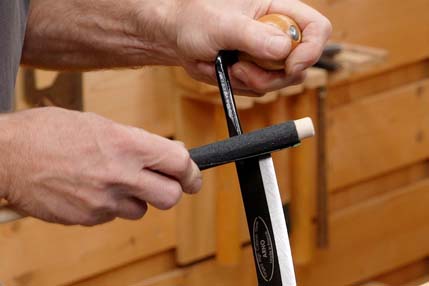
A slightly concave drawing knife is sharpened with sandpaper
If the bevel is on the inside of the curvature, then it cannot be sharpened on a straight sharpener. Curved tools with the bevel on the inside are, for example, drawknives, adzes, some woodturning tools (hook tools, etc.), spoon gouges and cornerblock gouges used in violin making. With these tools, the back side is curved outwards and is only honed with a flat polishing stone or on leather. With spokeshaves and beading planes, the back of the blade is flat and therefore fully rests on the polishing stone when honed, although they also have concave cutting edges. Blades with a double bevel, which are curved inwards, can be found, for example, on carving knives, on pruning or grafting knives, on some leather knives and in the kitchen on peeling knives.
Which sharpening tools are suitable for concave blades?
If you only have one or a few of these tools, it is probably not worth buying special shaped stones in the different grit sizes. You need at least one coarse, one medium and one fine grit for sharpening. The simplest option is to wrap a round bar of a suitable diameter with sandpaper of different grit sizes instead and use it to work the bevel surface. This procedure is suitable for drawknives, for example. Always hold the tool with the blade pointing away from you. If you sharpen with the cutting edge pointing in your direction, there is a risk of injury.
If you have several such tools, then it may well be worthwhile purchasing shaped stones in the various grits. These shaped stones are available in a cone shape, half-round shaped or as small slabs with a round edge. Depending on the curve of the cutting edge, you can also round off one of the lower edges of your bench stone and use this to sharpen the bevel. To round the edge, your trueing tool, e.g. a trueing block or waterproof abrasive paper can be used on a flat surface.
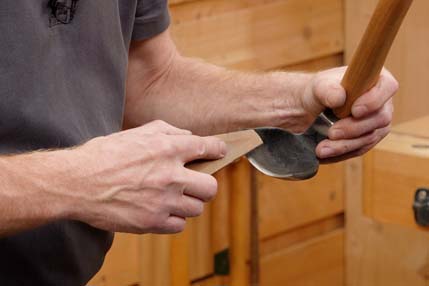
Shaped stones like this conical slipstone are ideal for sharpening concave cutting edges
Very tightly curved blades and tools with little space for sharpening tools can be sharpened using a drill or multi-sander in which you clamp a rod-shaped or tapered sharpener. Honing is done with a beading stone or with polishing paste on a piece of leather glued to a round wooden surface (round bar).
Adjusting the plane blade to the plane sole of spokeshaves and beading planes
In the case of rabbet planes and beading planes, where the blade no longer matches the plane sole due to frequent resharpening, the exact shape of the plane sole must first be transferred to the blade. First, mark the back of the blade with a waterproof felt-tip pen or special marking varnish. Put the blade into the plane and let the cutting edge protrude far enough from the plane sole. You can then scribe the shape of the plane sole exactly on the blade with an awl.
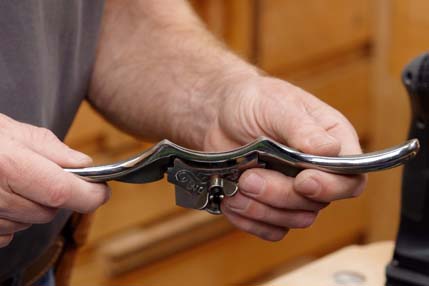
With spokeshaves, the shape of the blade must match the plane sole
First, grind the contour of the cutting edge at right angles using files or a machine. It is almost impossible to create the exact shape directly during sharpening. The surface that is created at the front of the cutting edge then shows you where you need to remove material. Now grind at the appropriate angle, e.g. 25°, only where this area is particularly wide, until you have an evenly wide surface at the cutting edge. This area is now ground as evenly as possible until it disappears. Now the blade can be sharpened and honed with the above mentioned sharpening devices.


